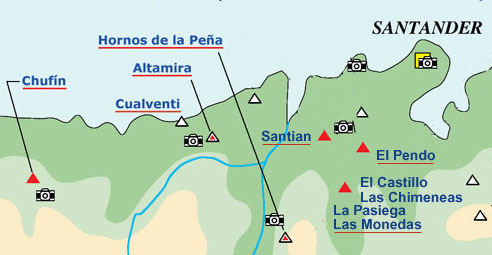Photo Archives: Paleolithic Art in Northern Spain
Las Chimeneas
Preview Edition
- 36 photos(about1280x1000,1470x980/JPEG) .
- Commentary by César González Sainz & Roberto Cacho Toca, Univ. of Cantabria.
- Royality Free for private and educational use.
In this downloadable photo archives are contained 36 photos of Paleolithic cave art of Las Chimeneas cave with the archeological data and commentary as shown in this preview pages. Only the small sized reference images and a part of commentary are shown in this preview edition, but if you are interested to see more and to use these photos, please go to Kagi store and purchase the data package. Once payment has been made at the Kagi store, you will receive an e-mail containing the URL to download the data package. All photos that are contained in this package are ROYALITY FREE for private and educational use.
Las Chimeneas Cave
 Cueva de Las Chimeneas is situated in the hill Monte Castillo, in the town of Puente Viesgo in Cantabria. Together with its neighboring caves of El Castillo, La Flecha, La Pasiega and Las Monedas, it forms part of the most amazing Paleolithic site in the Iberian Peninsula, where a significant part of the cave art known in Spain is concentrated.
Cueva de Las Chimeneas is situated in the hill Monte Castillo, in the town of Puente Viesgo in Cantabria. Together with its neighboring caves of El Castillo, La Flecha, La Pasiega and Las Monedas, it forms part of the most amazing Paleolithic site in the Iberian Peninsula, where a significant part of the cave art known in Spain is concentrated.
Las Chimeneas was discovered in the middle of the 20th Century, long after the discovery of another two important caves with Paleolithic art in the same hill: El Castillo in 1903 and La Pasiega in 1911. In 1950, construction work was under way to make it easier for tourists to visit these two caves, and this involved cutting a track round the side of the hill, from Cueva de El Castillo to La Pasiega. During this work two new caves were found, Las Monedas and La Flecha. Shortly after, in 1953, another cave was discovered, although its exploration revealed no evidence that it had ever been occupied during the Paleolithic. Then, some pits in the floor were descended to a lower passage, which gave positive and surprising results; the walls of this passage had been decorated with paintings and engravings, of animals and abstract signs, in the Upper Paleolithic. The high level passage had so many of these vertical pits that the cave was known as Cueva de Las Chimeneas (Cave of the Chimneys).
--------------------------
[References]
Moure Romanillo, A.; González Sainz, C.; Bernaldo de Quirós.; Cabrera Valdés, V. 1996. Dataciones absolutas de pigmentos en cuevas cantábricas: Altamira, El Castillo, Chimeneas, Las Monedas. En Moure, A. (ed.): "El Hombre fósil" 80 anos después. Servicio de Publicaciones. Universidad de Cantabria. Santander, pp 295-324.
González Echegaray, J. 1974. Pinturas y grabados de la cueva de Las Chimeneas (Puente Viesgo, Santander). Diputación Provincial de Barcelona. Instituto de Prehistoria y Arqueologia. Wenner Gren Foundation for Anthropologicla Research. Monografias de arte rupestre. Arte Paleoliico, No. 2. Barcelona.
|
Photographed by Takeo Fukazawa & Co-Project Team of Texnai Inc. and the University of Cantabria
Commentary by César González Sainz & Roberto Cacho Toca, Univ. of Cantabria
Texnai Inc.:
2-1, Udagawa-cho, Shibuya-ku, Tokyo, Japan. Tel:03-3464-6927 Fax:03-3476-2372
e-mail:info@texnai.co.jp
Copyright reserved by Takeo Fukazawa &Texnai, Inc., University of Cantabria, IPA
|
|